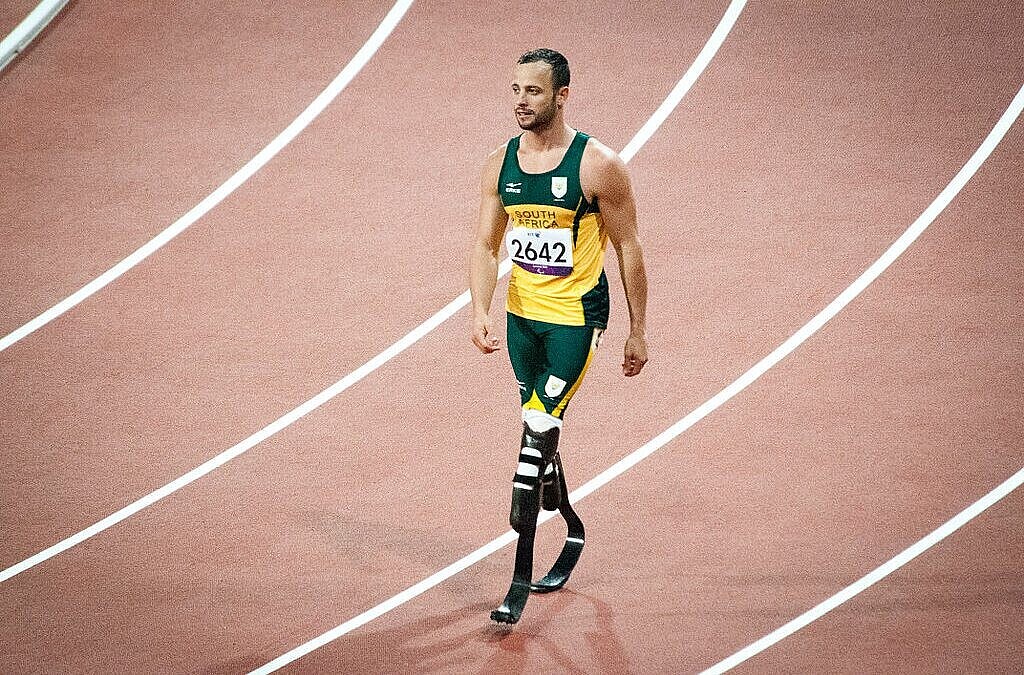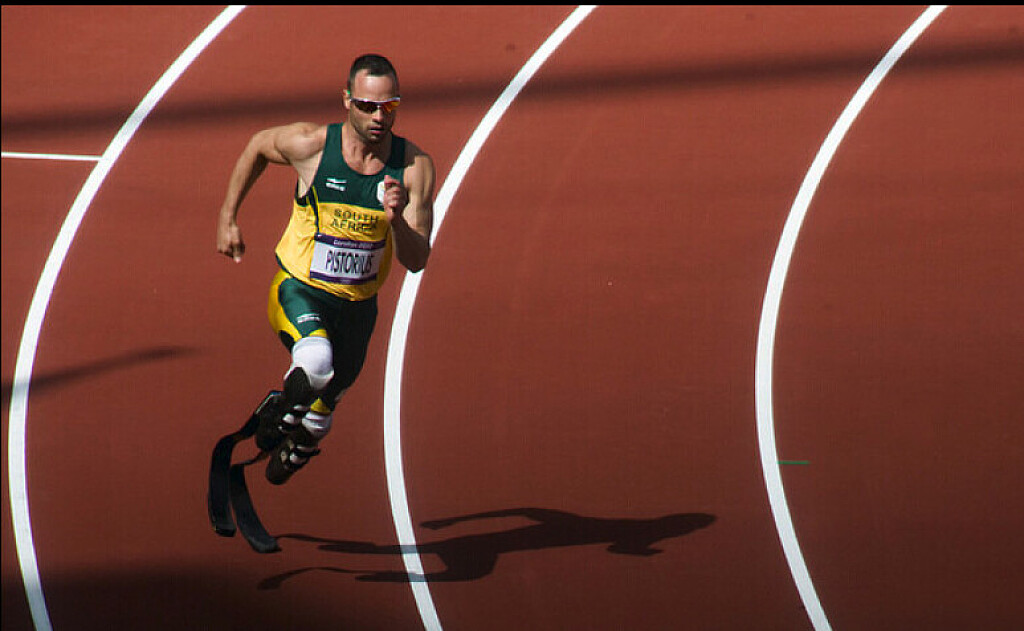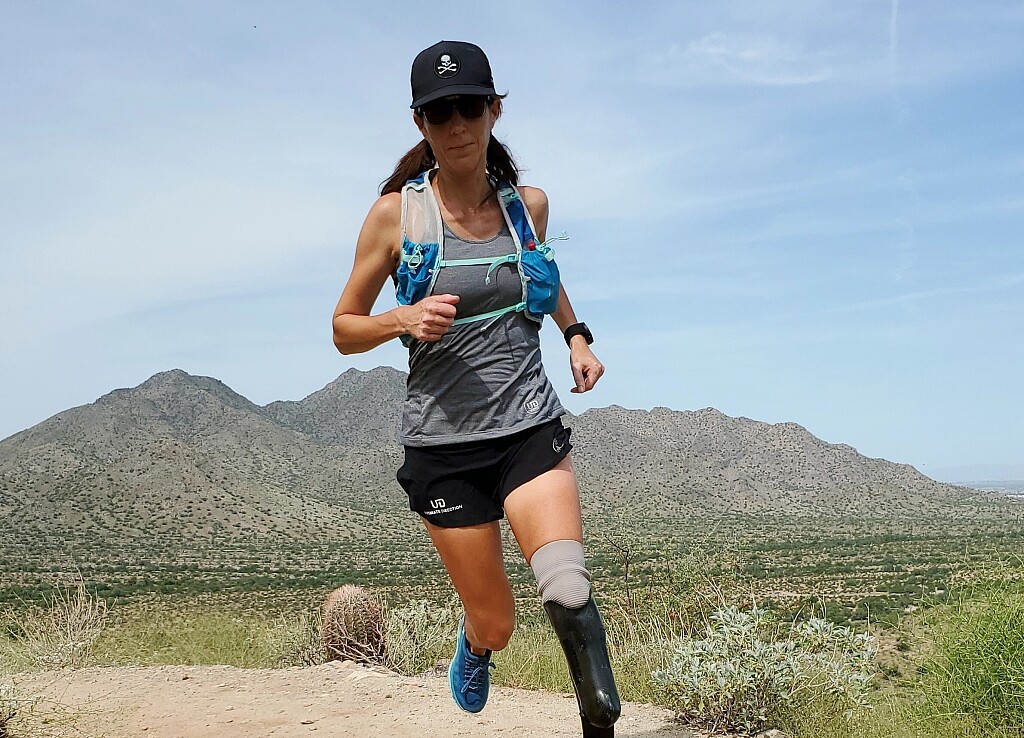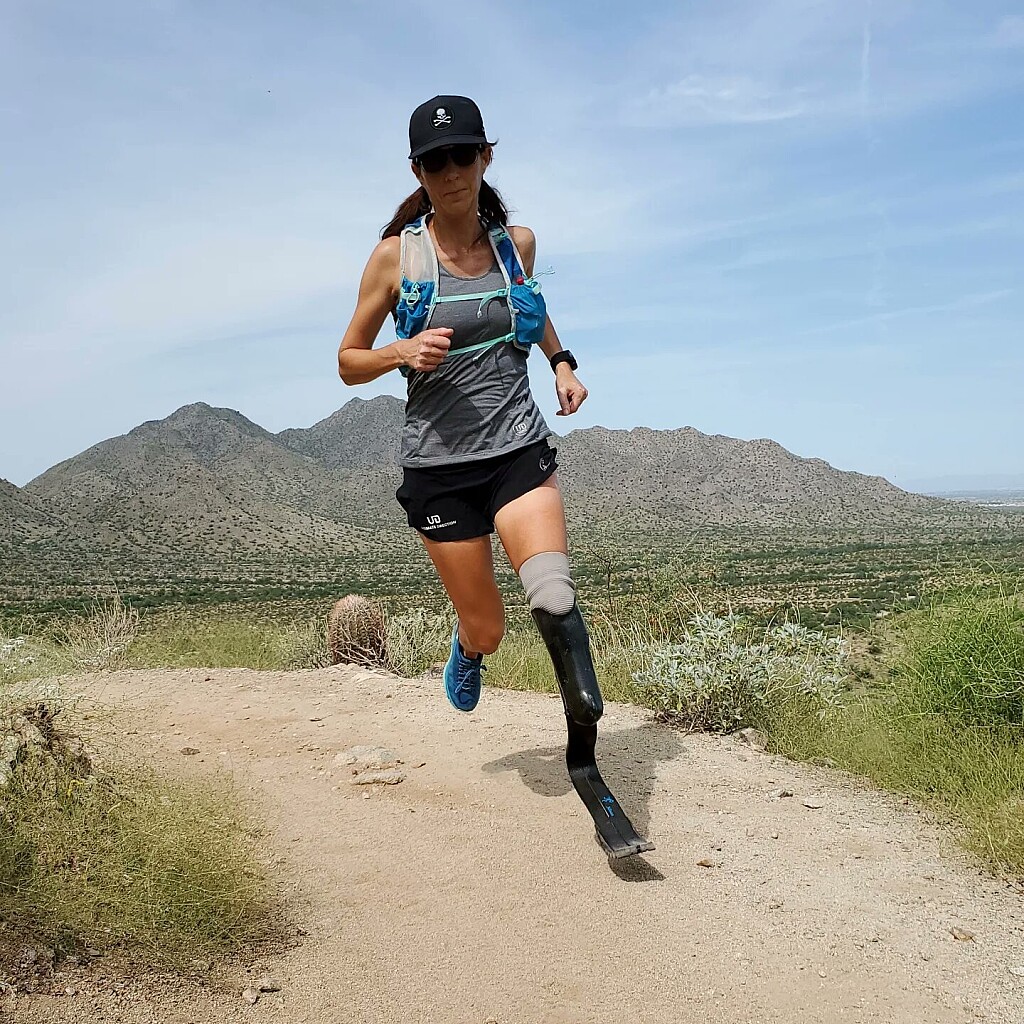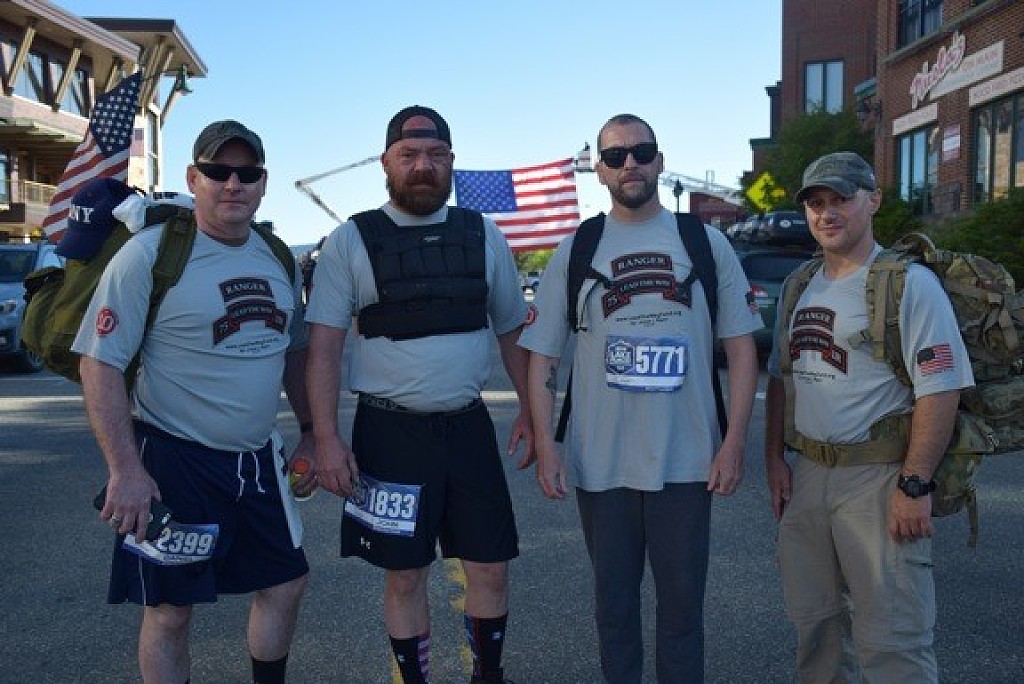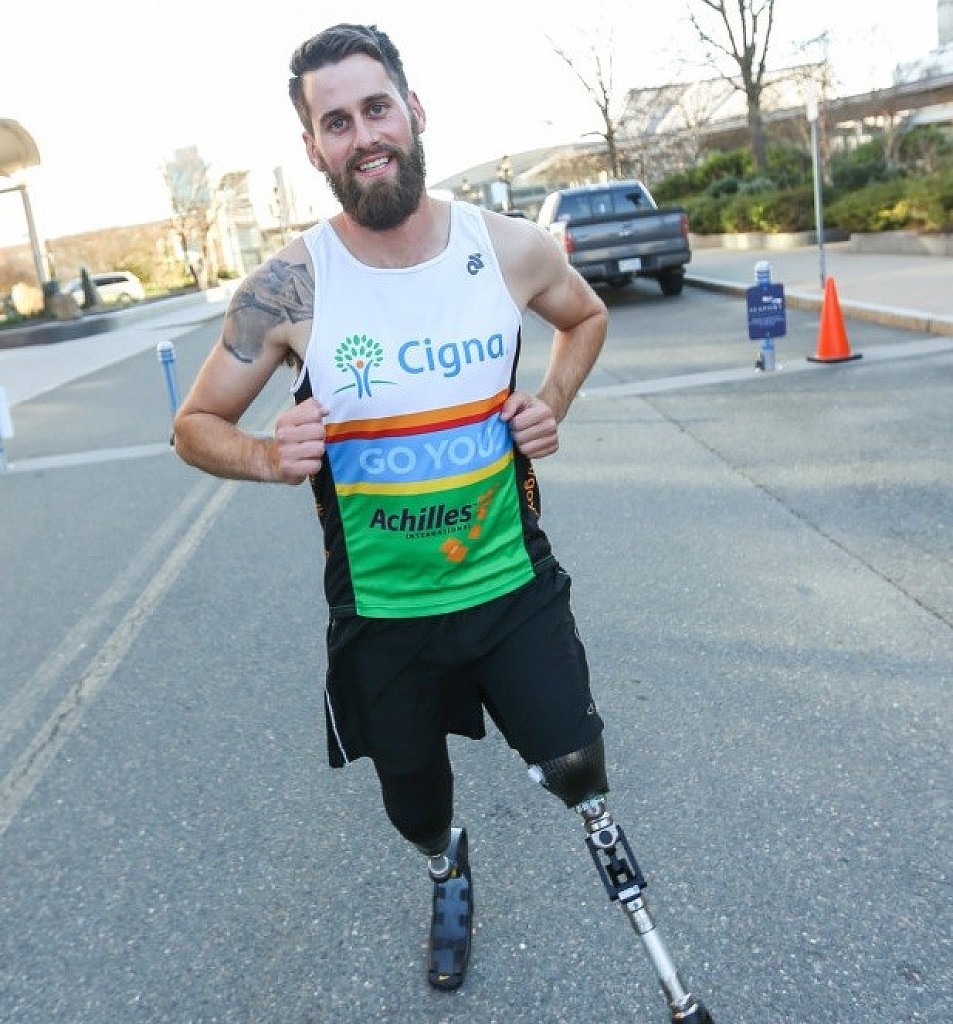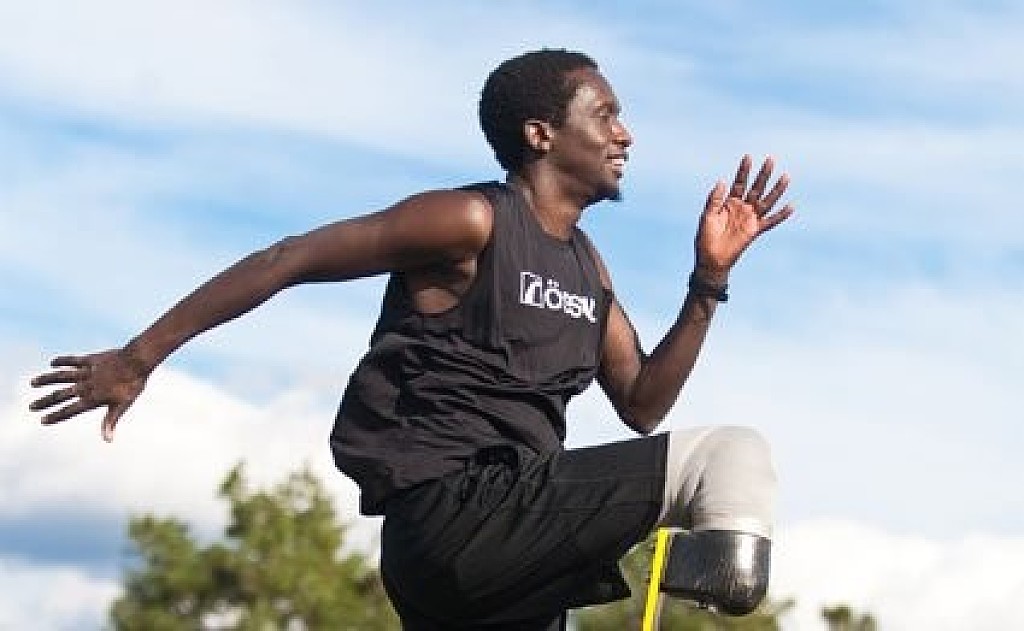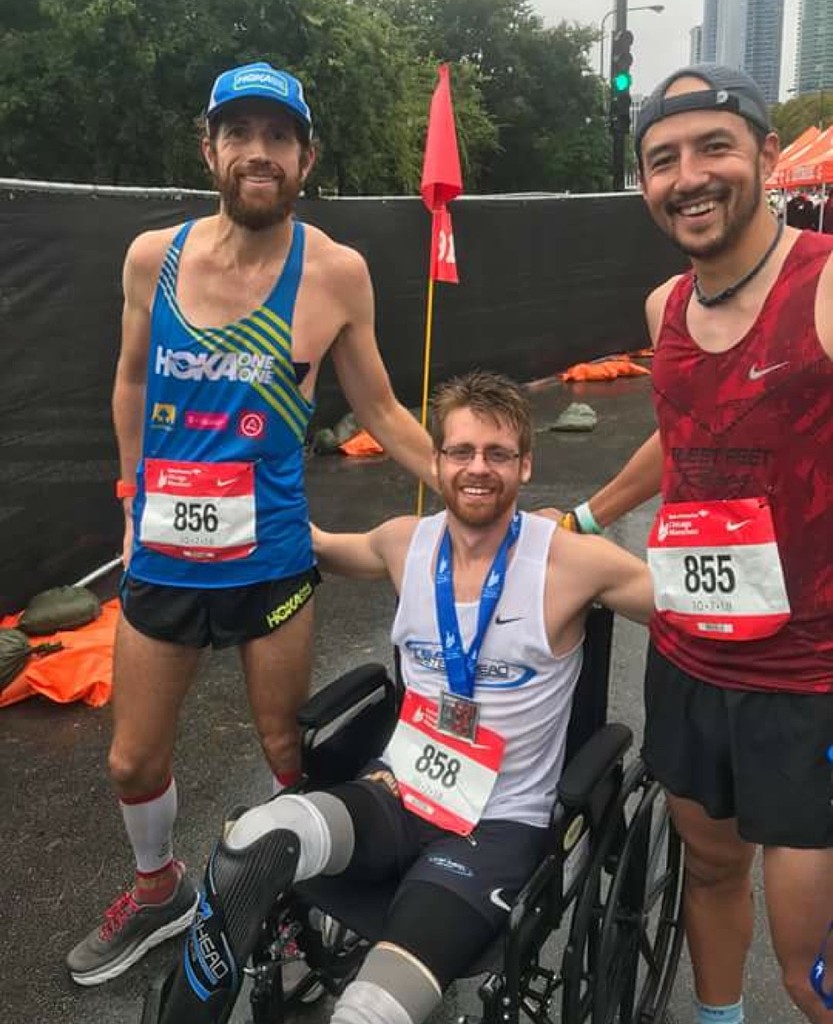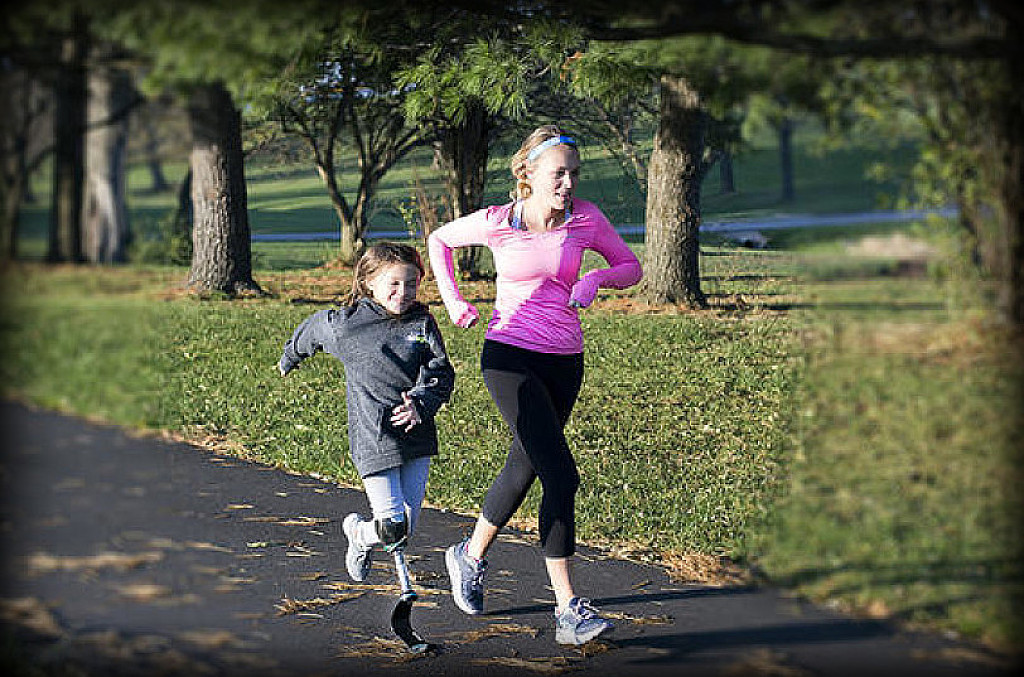Running News Daily
Running News Daily is edited by Bob Anderson in Mountain View, California USA and team in Thika Kenya, La Piedad Mexico, Bend Oregon, Chandler Arizona and Monforte da Beira Portugal. Send your news items to bob@mybestruns.com Advertising opportunities available. Over one million readers and growing. Train the Kenyan Way at KATA Running Retreat Kenya. (Kenyan Athletics Training Academy) in Thika Kenya. Opening in june 2024 KATA Running retreat Portugal. Learn more about Bob Anderson, MBR publisher and KATA director/owner, take a look at A Long Run the movie covering Bob's 50 race challenge.
Index to Daily Posts · Sign Up For Updates · Run The World Feed
Articles tagged #amputee
Today's Running News
Blade runner Oscar Pistorius released on parole
Eleven years after shooting and killing Reeva Steenkamp through a bathroom door in their home in Pretoria, South Africa home, double-amputee runner and six-time Paralympic gold medallist Oscar Pistorius, 37, was released on parole on Friday.
On Valentine’s Day in 2013, Pistorius, known as the “Blade Runner,” fired numerous shots through a bathroom door in his home, killing Steenkamp, who was inside. The South African athletics star consistently denied intending to kill her, saying he shot her by mistake, believing she was an intruder.

Pistorius was initially convicted of the lesser charge of culpable homicide and sentenced to five years in prison, but after an appeal by prosecutors, he was found guilty of murder in 2016 and the sentence increased by a further six years. In 2017, according to a report in the Globe and Mail, his sentence was more than doubled, after South Africa’s Supreme Court of Appeal decided it was too lenient. In 2021, it was announced he would soon be eligible for parole, having served half his sentence.
South Africa’s Department of Corrections did not give details as to when and how Pistorius would be released, saying “Inmates and parolees are never paraded. Pistorius’ public profile does not make him different from other inmates nor warrant inconsistent treatment,” the Department of Corrections said in a statement Wednesday.

The 37-year-old will be under correctional supervision for the remainder of his murder sentence of 13 years and five months expires in December 2029. Pistorius will also undergo therapy for anger and gender-based violence issues, according to a report.
Pistorius competed in the 2004 Summer Paralympics in Athens, finishing third overall in the T44 100m and winning gold in the 200m; he went on to compete again in 2008, winning gold in the 100m, 200m and 400m. He wanted to compete against able-bodied runners, but the IAAF (now World Athletics) ruled that runners using carbon-fibre prosthetic “blades” had an unfair advantage and could not race against able-bodied athletes. Pistorius fought this ruling and won, and the rule was revoked, clearing the way for him to try to qualify for the 2008 Olympics in Beijing. (Further studies have also concluded that prosthetic blades do not confer an advantage over able-bodied runners.)
(01/05/2024) Views: 306 ⚡AMPby Marley Dickinson
Oscar Pistorius
Things you didn’t know about the Ottawa International Marathon
The Ottawa Marathon turns 50 in 2024, and there’s no better way to celebrate than to be a part of Canada’s largest and most historic spring marathon, which will take place on May 26. Through the years, the marathon has seen everything from warm temperatures to course records and Olympic dreams, not to mention all the Boston qualifiers. But there’s a lot you might not know about Canada’s capital city marathon.
1975: Only 3 women ran the first Ottawa Marathon
Ottawa has always been one of Canada’s premier running cities, and on May 25, 1975, a 42.2 km route was designed, starting and finishing at Carleton University. The race’s beginnings were modest, with only 146 runners finishing the inaugural marathon. Compared to recent registration numbers (30,000 plus), it’s next to nothing, but in 1975, it was already Canada’s biggest marathon.
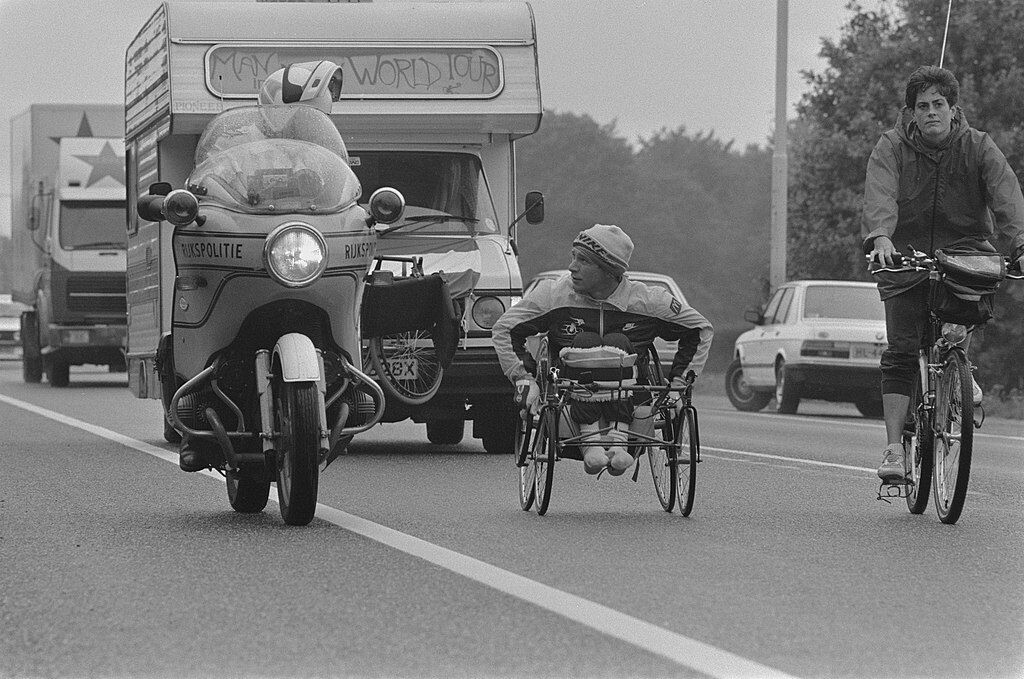
The race was called the National Capital Marathon and was won “by accident” by Quebec middle-distance runner Mehdi Jaouhar, who entered the race with his roommate. Only three of the 146 finishers were women.
1976: The Ottawa Marathon champion had lunch with the Queen

This year was a special one for athletics in Canada, as the country hosted the 1976 Summer Olympics (still the only Summer Olympics our nation has hosted to date). The marathon quadrupled in size from the previous year, and the stakes and competition rose accordingly. The race was selected as the location for the 1976 Olympic Trials for the Canadian marathon team, attracting some of Canada’s top marathoners.
Toronto’s Wayne Yetman set a new course record of 2:16:32, earning a spot on the Canadian Olympic team for Montreal. Also included in his Olympic moment was lunch with Queen Elizabeth. Eleanor Thomas won the women’s marathon for the second year in a row, yet she didn’t take in any water or electrolytes on the course. Thomas was a smoker at the time, and famously said “quitting smoking was harder than running a marathon.”
1983: Man in Motion Rick Hansen raced the Ottawa Marathon
In preparation for his famous Man in Motion World Tour, Rick Hansen won the inaugural wheelchair division at the Ottawa Marathon in 1983. Previously, wheelchair athletes competed in the open field. Hansen was the pioneer of the wheelchair division in Canada after winning gold, silver and bronze medals at the 1980 Paralympic Games. He became the first Canadian Para athlete to win the wheelchair division at the 1982 Boston Marathon.
Between 1985 and 1987, Hansen wheeled more than 40,000 kilometers around the world through 34 countries to raise awareness about people with disabilities. The world tour started and ended on the Port Mann Bridge in Vancouver.
1986: The marathon almost ended
After a major decline in numbers in 1984 and 1985, race organizers and the board of directors voted to cancel the event. The marathon faced new competition with the Montreal Marathon earlier in the spring, and Ottawa was having trouble attracting sponsors. However, after the cancellation announcement new sponsors emerged and organizers were able to move forward and add a 10K race.
The first Ottawa 10K attracted just fewer than 1,000 participants, but by 1988, that number doubled and continues to grow today as the premier event on Saturday of Ottawa Race Weekend.
4: Montreal’s Jean Lagarde won 4 straight marathons between 1993 and 1996
Lagarde had come to Ottawa to cheer on his friend in the marathon, but when he got there, the friend persuaded him to sign up. Lagarde thought, “Why not?” By eight kilometres, Lagarde was out front and on his own, and he held on to win his first of four straight Ottawa Marathons. Lagarde trained for the marathon by running 35 km every Sunday.
Lagarde’s best time in Ottawa was in 1994, when he ran 2:19:00. He also holds another impressive record, winning both the warmest and the coldest Ottawa Marathon to date (25 C and 1 C). Keep in mind that the date of the marathon at the time was the second week of May. He is still the only man to win four consecutive Ottawa Marathons.
Russian-Canadian runner Lioudmila Kortchaguina has also won the marathon four times, holding the record for the most women’s titles. She has raced the Ottawa Marathon more than 20 times, and she was the last Canadian woman to win (in 2007) until Kinsey Middleton won in 2022.
1995: The race weekend had an inline skating race
To boost registration numbers and add a Canadian twist to Ottawa Race Weekend, organizers held the inaugural inline skating 8K at the 1995 Ottawa Marathon. Hundreds of participants signed up with their skates, gloves and helmets to skate a timed portion of the course.
The inline 8K race didn’t last long; it was canceled the next year due to frosty conditions.
1998: Ottawa was the first Canadian marathon to have pace bunnies
Where did pace bunnies come from? Well, the Chicago Marathon was the first race to implement pace bunnies in North America. After Hilda Beauregard of Ottawa participated in the 1997 Chicago Marathon, she noticed that the race had provided pace bunnies in the mass field to help runners achieve their goal times. The runner brought the idea back to Ottawa, and the 1998 Ottawa Marathon became the first Canadian marathon to use pace bunnies.
Every year since, pace bunnies have been a regular component of the marathon, wearing caps with rabbit ears while holding marked signs with the projected finishing time, helping runners hit their goals.
1996: There was a blizzard during the marathon
Though temperatures are typically warm for the Ottawa Marathon, which is in late May, there was snow for the 1996 race. Four thousand runners experienced below-zero temperatures and 35 km/h winds, with snow squalls. The 1996 race still stands as the coldest marathon in the event’s history.
2010: Paralympian Rick Ball achieved a single-leg amputee marathon world record in Ottawa
At the 2010 Ottawa Marathon, Rick Ball of Orillia, Ont., became the first single-leg amputee athlete to run a sub-three-hour marathon. Ball clocked 2:57:48 to break the world record. He held onto that record for seven years, until it was broken in 2017 by Lebanon’s Eitan Hermon at the 2017 Vienna Marathon, who finished in 2:56.53.
49 years of Ottawa Marathons
Ottawa’s Howard Cohen has completed his local race every year since the inaugural marathon in 1975. The retired physician has never missed a race, overcoming various challenges such as the 30 C heat threat that almost canceled the marathon in 2016, enduring a snowstorm in 1996, and even completing the 42.2K race with canes due to a torn hamstring injury.
Cohen has consistently found a way to make it to the start line and cross the finish. At 73, he has participated in the event virtually for the past four years, with his last in-person race dating back to 2019. Cohen was the first runner to register for the 2024 Tartan Ottawa International Marathon virtually, which will mark his remarkable 50th race.
(12/29/2023) Views: 317 ⚡AMPby Marley Dickinson
Ottawa Marathon
As one of two IAAF Gold Label marathon events in Canada, the race attracts Canada’s largest marathon field (7,000 participants) as well as a world-class contingent of elite athletes every year. Featuring the beautiful scenery of Canada’s capital, the top-notch organization of an IAAF event, the atmosphere of hundreds of thousands of spectators, and a fast course perfect both...
more...Double amputee Oscar Pistorius granted parole in girlfriend’s murder
Ten years after shooting and killing Reeva Steenkamp through a bathroom door in their home, double amputee runner and six-time Paralympic gold medalist Oscar Pistorius, 37, of South Africa is to be paroled and will be released from prison on Jan. 5, 2024.
On Valentine’s Day in 2013, Pistorius, known as the “Blade Runner,” fired numerous shots through a bathroom door in his home, killing Steenkamp, who was inside. The South African athletics star consistently denied intending to kill her, saying he shot her by mistake, believing she was an intruder.

Pistorius was initially convicted of the lesser charge of culpable homicide and sentenced to five years in prison, but after an appeal by prosecutors, he was found guilty of murder in 2016 and the sentence increased by a further six years. In 2017, according to a report in the Globe and Mail, his sentence was more than doubled, after South Africa’s Supreme Court of Appeal decided it was too lenient. In 2021, it was announced he would soon be eligible for parole, having served half his sentence.
Pistorius competed in the 2004 Summer Paralympics in Athens, finishing third overall in the T44 100m and winning gold in the 200m; he went on to compete again in 2008, winning gold in the 100m, 200m and 400m. He wanted to compete against able-bodied runners, but the IAAF (now World Athletics) ruled that runners using prosethetic blades had an unfair advantage and could not race against able-bodied athletes. Pistorius fought this ruling and won, and the rule was revoked, clearing the way for him to try to qualify for the 2008 Olympics in Beijing. (Further studies have also concluded that prosthetic blades do not confer an advantage over able-bodied runners.)
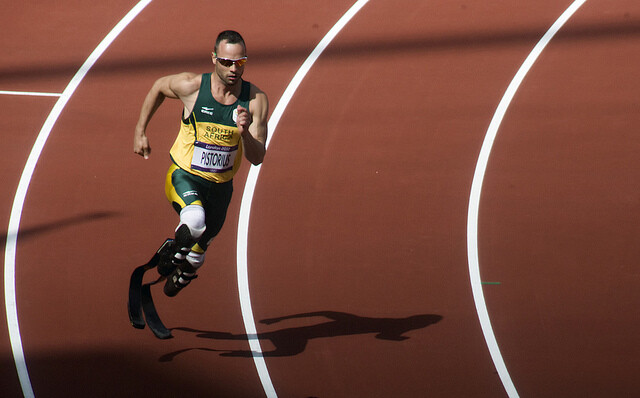
For various reasons, Pistorius did not compete in the Olympics until 2012 in London, where he became the first amputee runner to compete in an Olympic Games. He reached the semi-finals of the 400m, where he finished eighth, and competed in the 4x400m relay, where the South African squad finished eighth out of nine. Pistorius carried the South African flag in the closing ceremonies.
(11/24/2023) Views: 364 ⚡AMPby Anne Francis
B.A.A. Announces Expanded Para Athletics Divisions and Enhanced Prize Money Awards for 2024 Events
The Boston Athletic Association (B.A.A.) today announced plans for an enhanced prize money structure across B.A.A. events in 2024, as well as the introduction of two new Para Athletics Divisions for athletes competing with coordination impairments (T35-T38) and intellectual impairments (T20) as well as more inclusive upper and lower limb impairment divisions. The changes will provide greater financial rewards for athletes across multiple divisions and expanded opportunities for athletes within the Para Athletics Divisions and Wheelchair Divisions.
“We are always looking at ways to celebrate and reward athletic excellence,” said Jack Fleming, B.A.A. President and CEO. “With these changes, we are recognizing top finishers and aspiring athletes in our Wheelchair and Para Athletics Divisions, while also expanding opportunities for new groups of athletes to be recognized and included in our B.A.A. events.”

He continued, “Boston is a running city, and we’ve made it our goal to elevate Para athletes as they train and compete for the podium at our events, from the 5K through to the marathon.”
“This creates an enormous positive impact for Para athletes and shows how the B.A.A. is leading the way towards greater inclusivity in sports,” said John Jordan, head of The Academy and executive co-sponsor of the Disability Action Network, Bank of America. “As we look across our involvement in sports around the world, we’re committed to help broaden the possibilities available to athletes competing at all levels.”

New prize structures highlights:
The Boston Marathon presented by Bank of America will now feature a cumulative prize fund of more than $1 million.
Wheelchair champions [T53/54/34] at the Boston Marathon presented by Bank of America will now receive a first-place prize of $40,000 (increased from $25,000), and places 2-10 will also receive increases in awards compared to recent years. Wheelchair athletes with T51-T52 classifications will receive awards for places 1-3.
The total wheelchair prize for 2024 will be $313,500 for men and women (previously $125,000). This includes $50,000 each for a course record (equal to the Open course record award)
The top three finishers in all seven Para Athletics Divisions at the Marathon will receive prize money of $2,500; $1,500; $1,000, respectively.
Additional increases in the Wheelchair Division and Para Athletic Division prize money will be offered for the B.A.A. 5K, B.A.A. 10K, and B.A.A. Half Marathon. The B.A.A. Half Marathon will also feature increased open division prize money for podium finishers.
Para and Wheelchair prize money divisions at the Boston Marathon adhere to World Athletics and World Para Athletics rules of competition. Athletes competing in the Para and Wheelchair divisions must be nationally or internationally classified to be eligible.
Overview of new Para Athletic divisions:
Seven Para Athletics Divisions will now be offered at the Boston Marathon presented by Bank of America, with newly established divisions for athletes with coordination impairments [T35-T38 and intellectual impairments [T20].
Additionally, the T61/63 lower limb impairment will now add the T43 classification, and the T62/64 lower limb impairment division will now add T42/T44 classifications.
The seven divisions are an increase from five divisions offered in 2023 (vision [T11/T12, T13], upper-limb [T45/T46], and lower-limb impairments [T61/T63, T62/T64]).
A Para Athletics Division for athletes with coordination impairments will be offered at the B.A.A. Half Marathon, B.A.A. 10K, and B.A.A. 5K from 2024. Each of these events will now feature four Para Athletics Divisions namely vision, upper-limb, lower-limb, and coordination impairments.
Athlete Quotes
Marko Cheseto - Kenyan All-American athlete who holds the world record for a double lower leg amputee in the marathon said, “This increased recognition [from the B.A.A.] gives athletes with disabilities more public attention, and we can perform at a higher level given these opportunities.
“Now that we have the world’s oldest marathon leading the way [with prize money for Para divisions] all other marathons should be inclusive. It's about diversifying the sport and creating more avenues for people with disabilities to compete, so we continue to grow the sport for future generations.”
Daniel Romanchuk, US Paralympian and two-time Boston Marathon winner said, “The B.A.A. has championed the wheelchair division for many decades and continues to build on that tradition by including more Para-athlete divisions, allowing an ever-increasing number of athletes to compete.
“Increased prize money makes it possible for emerging athletes to attend elite-level races as well as helping them afford the costly equipment and repairs that are necessary to compete in Para-athletics. The B.A.A. is continually finding ways to elevate the sport, and it's incredibly exciting to imagine the future of Para-athletics!”
Reigning Boston Marathon Champion, and multi-World and Paralympic Champion from Switzerland, Marcel Hug said, “To see how the sport of wheelchair racing has developed in recent years is very gratifying and it is also a credit to the Boston Athletic Association. It is not only about the financial support which enables us to train and compete at a higher level, but it is also about the increased recognition and inclusion of Para-sports.
“As top athletes we try to perform at our best and inspire other people with or without disabilities so the support of the B.A.A. and the entire Abbott World Marathon Major series is more than just rewarding top performing athletes, it shows that we are an equal part of society.”
Tatyana McFadden, 21-time Abbott World Marathon Major winner from America said,“I’m proud to see how far we have come. I’m thankful for past, and for current athletes who have raised their voices to help create change. Change takes more than just one person, it takes a village, and takes people who believe in us. The B.A.A. has been part of that, so I am very thankful.
“The prize money is so important to support the elite Para divisions. The more support, visibility and education we can bring to the sport, the better it can be for all the athletes.”
Susannah Scaroni, Paralympic Gold medalist and the 2023 Boston Marathon Champion from America said, “The legacy of the Boston Marathon and its support of the wheelchair division has impacted me in so many ways.
“As a person with a disability, the legacy of the original 1970 wheelchair athletes has enabled myself and all other Para-athletes of my generation to perceive ourselves and to be perceived publicly, as professional athletes. I cannot express how much this has meant for all of us.
“The provision of prize money indicated that the B.A.A. truly recognized that wheelchair racers are elite athletes, and this support has enabled the sport to grow and improve and subsequently gives more people with disabilities exposure to role models.”
Liz Willis, Paralympian and three-time Boston Marathon Para Champion said, “The support of the B.A.A. for Para divisions is vital to expanding the Para movement. Just as the Boston Marathon was the first Abbott World Marathon Major to open the doors of possibility for women, they are doing the same for amputees and visually impaired athletes.
"It takes time and recognition to build a program, and the B.A.A. is the ONLY reason I currently run marathons. The Boston Marathon allows others to see their impossible become possible. It has forever impacted my life by breaking down the walls of discrimination and providing pathways for all to push their limits of what's possible.”
(09/07/2023) Views: 406 ⚡AMPby B.A.A. Communications Department
B.A.A. Half Marathon
Dana-Farber and the Jimmy Fund have partnered with the B.A.A. in the Half Marathon for 13 years as the race’s presenting sponsor. Through this relationship, team members have collectively raised more than $5 million to support groundbreaking cancer research, and enabled Dana-Farber scientists and clinicians to positively impact the lives of cancer patients around the world. Dana-Farber runners often participate...
more...Amputee ultrarunner Jacky Hunt-Broersma takes on 5,250 kilometer challenge for cancer research
Bladerunner Jacky Hunt-Broersma celebrated being 21 years cancer-free by setting out on a new challenge: the Arizona-based athlete and coach will be running a half marathon a day (21.1K a day) from Aug. 1 until she reaches 5,250 kilometers. Aug. 1 is both the athlete’s amputee anniversary and marks 21 years of being cancer-free, she shared on social media, and this challenge is to honor cancer survivors, those fighting cancer and those who have lost their lives.
Dubbed the ‘Doing Hard Things’ project, Hunt-Broersma chose the distance to represent the number of people fighting cancer each day.”I had Ewing sarcoma,” the runner shared. “I was one of the lucky ones to survive and I’m so grateful to be alive and be able to move. I think movement is so important to not only keep us healthy but also help us cope mentally.”

Hunt-Broersma is raising funds for cancer research and will be dedicating each day to someone fighting cancer or who has lost their life to the disease, and guesses it will take her about 250 days to complete the distance.
Hunt-Broersma lost her lower left leg to Ewing sarcoma, a rare form of cancer that affects the tissue around bones, in 2002. While she always lived a healthy lifestyle, she didn’t start running until 2016, when she signed up for a 5K race. Taking on challenging adventures is not new for Hunt-Broersma: she ran 104 marathons in 104 days in 2021, raising over $200,000 for amputee runners, and ran 50K a day for two weeks in July 2022.

The name of her latest project comes from a phrase that carried her through her 104 marathon streak. “When I was running the 104 marathons in 104 days I’d often need encouragement and I’d whisper to myself ‘you can do hard things’ to keep me going when it got really hard,” she explains. “At one point during the marathons, I started believing in myself and that whisper changed to a louder mantra: ‘I can do hard things, I can do hard things.’ ”
The athlete invites runners and walkers of all levels to come out and join her on her daily half-marathon, and will be sharing the location and times of her runs on social media. Runners can show their solidarity from afar by joining the Strava group she has created, called “I can do hard things.” Hunt–Broersma wants everyone to feel included, she shared on Instagram. “I’m hoping it will create an encouraging space where everyone will feel welcome.”
(08/03/2023) Views: 613 ⚡AMPby Keeley Milne
Study finds blade runners do not have a competitive advantage
Are prosthetic, “man-made” limbs more efficient or powerful than biological legs? This has been debated in track and field circles for years, but recent research suggests what amputee runners have known all along–they aren’t. At least, not over 400 metres.
A recent study from the University of Colorado at Boulder found that blade runners, including the world’s fastest 400-metre sprinter, Blake Leeper of Tennessee, have no competitive advantage over non-amputee runners. Instead, they likely have a significant disadvantage.Prosthetic limbs, particularly those designed for athletic performance, have come a long way since Terry Fox made his inspiring, yet at times painful-looking, journey across Canada.

In the last decade, we’ve seen amputee runners run ultramarathons and set Guinness World Records, and many of us recall Oscar Pistorius, the double-amputee blade runner from South Africa who became the first to win a non-disabled medal at the 2011 World Track and Field Championships (he won silver in the 400m). Pistorius was later convicted of murder in the death of his girlfriend, Reeva Steenkamp, and remains in prison today.
Back in 2011, Pistorius had to take legal action against the IAAF (now World Athletics) to allow him to compete in the World Championships, since the governing body of track and field claimed his prosthetic limbs gave him an advantage over his competitors.
Leeper, who is also a double-amputee and the fastest blade runner over the 400m distance today, has faced similar rejection. He was ruled ineligible to compete at the 2020 Tokyo Olympic Games due to the perception that his “blades” gave him an unfair advantage.
The study
As it turns out, two legs do appear to be better than none, despite the incredible technology behind today’s prosthetic limbs. The study, published in the journal Royal Society Open Science, collected performance data from Leeper, Pistorius and six other bilateral amputee sprinters and compared that to the best non-amputee sprinters in the world across five performance metricLeeper also visited the researchers’ lab for a series of tests to measure his acceleration out of the starting blocks, maximum speed along straightaways and around curves, velocity at aerobic capacity and sprint endurance (all-out effort). This information was also compared to available data from elite non-amputee runners.
The research found that runners using prostheses were 40 per cent slower out of the starting blocks, had 19 per cent slower velocity at aerobic capacity and were one to three per cent slower around curves, compared to non-amputees.
“We found that no athlete with prosthetic legs has ever performed better than elite non-amputee athletes in lab-based experiments in any measure that relates to sprinting performance,” said first author Owen Beck.
The researchers presented their preliminary findings to the Court of Arbitration for Sport in 2020 in a bid to get Leeper to an Olympic start line, but the athlete was yet again deemed ineligible–the court ruled that his prostheses made him too tall. (The same researchers had found in a previous study that height did not provide an advantage when it comes to maximum sprinting speed, but Leeper was still ruled ineligible.)
While their results didn’t help Leeper this time, the researchers hope their work will change the conversation to provide more opportunities for amputee runners.
“A lot of assumptions have been made about running prostheses and performance with no data to support them,” said senior author Alena Grabowski, associate professor of integrative physiology at CU Boulder. “I hope this will get people to really question rules being put into place that keep athletes with disabilities from competing even when they have shown with science that they can compete fairly.”
(07/15/2023) Views: 424 ⚡AMPby Running Magazine
Kenya’s Hellen Obiri is moving to Colorado to pursue her marathon ambitions
When Hellen Obiri moves 14,000 kilometers from Kenya to Colorado later this year, she already knows she'll miss some of the comforts of home.
That includes Kenyan food and the country's staple of ugali -- a dense porridge made from maize flour.
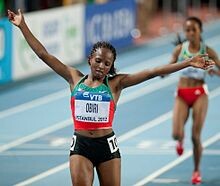
"Kenyans, we like eating ugali," Obiri tells CNN Sport. "I will have to find where I'm going to make my Kenyan food over there (in the United States)."
A good ugali may hold the keys to successfully fueling the next steps of her distance-running career. Obiri, a two-time world champion over 5,000 meters, is racing her first ever marathon in New York later this year, ahead of which she will team up with a new coach and new training group in Boulder, Colorado.
It's common for distance runners to make the move from track to road racing towards the end of their careers, but less common to do so by moving halfway across the world in the way Obiri has planned.
At the start of this year, the 32-year-old joined On Athletics Club (OAC), an elite team based in Boulder and led by former distance runner Dathan Ritzenhein. She hopes to move to the US next month in advance of racing the New York City Marathon on November 6.
"We've been wanting to move to the USA for training and to live there, so for me it's not a difficult move," Obiri, who will be based outside Kenya for the first time in her career, tells CNN.

"I think as an athlete and for my family, I want to move there to acclimatize well as soon as possible ... It will take me two weeks at least to get used to it and catch up with my training.
Boulder's high-altitude, rolling trails and temperate climate make it an ideal location for distance runners. There, Obiri will join a relatively new team in OAC, which was launched by the Swiss sportswear brand On in 2020.
Under Ritzenhein's guidance, Obiri has already started her marathon program and this week increases her training load from 180 to 200 kilometers of running per week. She begins the next chapter in her career having established herself as one of the best 5,000 and 10,000-meter runners in the world over the past five years.
Just last month, she won a silver medal in the 10,000m at the World Athletics Championships -- clocking a personal best of 30 minutes and 10 seconds -- and has won 5,000m silver medals at the past two Olympic Games to go alongside her two world titles in the event.
'It showed me how strong our bodies can be,' says amputee athlete Jacky Hunt-Broersma after running 104 marathons in 104 days
Her debut in New York will be the first indicator of how Obiri's track-running pedigree translates over the 26.2 miles of the marathon.
"I can't say I'm going to target this time or this time -- it's my debut," she says. "I can't say maybe I want to do sub 2:20, 2:25 because I know the New York Marathon is a tough course, especially the second half."
Starting on Staten Island, the challenging course undulates through New York's five boroughs before finishing down Fifth Avenue and into Central Park.
"For me, I want to train well because it's my debut, and for sure, I'm looking forward to running a good race -- I'm looking forward to running my own race with no pressure and to finish well," Obiri adds.
She says she will miss racing her favorite distance of 5,000m but won't fully hang up her track spikes with the switch to marathon running.
"You can't move up to the marathon without speed," Obiri explains, adding that she hopes to stay sharp by competing in 5,000m races in Kenya next year.
The immediate focus, however, is on getting settled with her family in the US. Obiri hopes, visa-depending, that her seven-year-old daughter, Tania, will move in time to watch the race in New York.
"She's going to be so excited to go outside the country," says Obiri. "She actually watches most of my races and she's so excited about me winning some races over there.
"When I'm out at a race, she knows mommy's not around, mommy's going out there to do some work. She actually calls me and says: 'Mom, do your best and be number one.' She always wants me to be number one."
Obiri's daughter won't be the only one holding high expectations at the NYC Marathon. Kenyan athletes have dominated the event over the past decade with eight winners in the women's race since 2010, and those watching back home will be hoping Obiri can add to that legacy.
But regardless of how she performs, when she winds her way through New York's five boroughs in November, Obiri will signal the start of a new stage in her running career and a new adventure for her family.
(08/10/2022) Views: 870 ⚡AMPby George Ramsay
TCS New York City Marathon
The first New York City Marathon, organized in 1970 by Fred Lebow and Vince Chiappetta, was held entirely in Central Park. Of 127 entrants, only 55 men finished; the sole female entrant dropped out due to illness. Winners were given inexpensive wristwatches and recycled baseball and bowling trophies. The entry fee was $1 and the total event budget...
more...Amputee ultrarunner Jacky Hunt-Broersma is running 50K a day
Bladerunner and Jacky Hunt-Broersma is celebrating being alive with her latest running challenge. Arizona-based athlete and coach Hunt-Broersma will be running 50 km a day until August 14, her birthday, when she will run 47 km to toast her age. Aug. 1 is both the athlete’s amputee anniversary and marks 20 years of being cancer-free, she shared on Instagram.
Hunt-Broersma lost her lower left leg to Ewing sarcoma, a rare form of cancer that affects the tissue around bones, in 2002. While she always lived a healthy lifestyle, she didn’t start running until 2016, when she signed up for a 5K race and rapidly progressed from there.
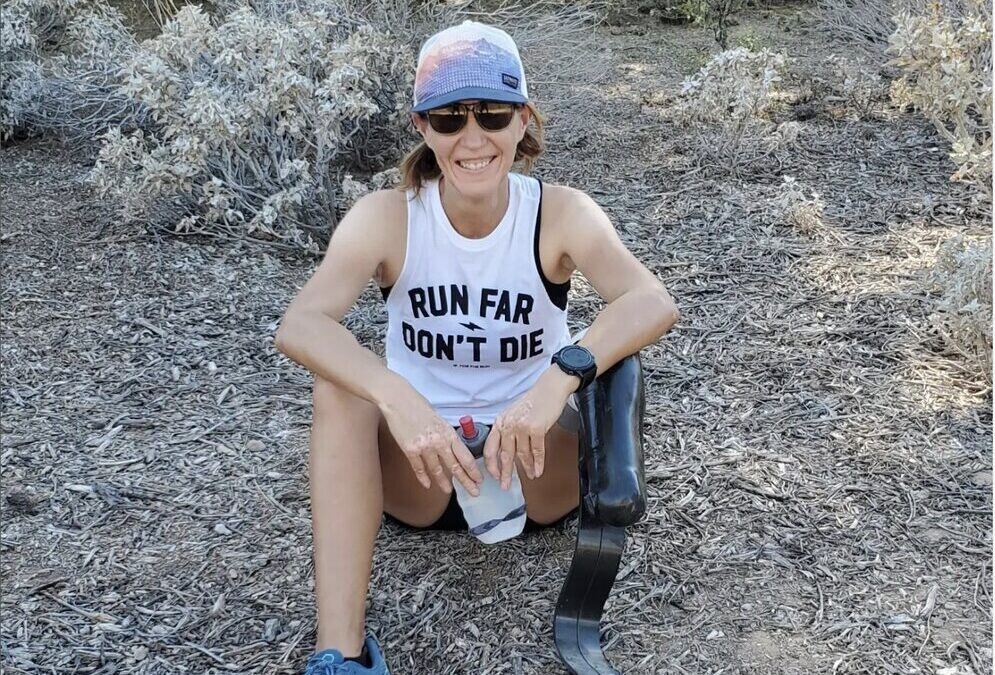
The athlete quickly progressed to marathons, trail races and ultras and is currently training for her second attempt at the Moab 240 ultratrail race.
Hunt-Broersma has continuously set the bar high in her running career–remarkable not only because of the hurdles she overcomes to compete but also because she used to hate running. She ran 104 marathons in 104 days earlier this year, breaking the record (at that time) for most consecutive marathons.
While her record has also since been beaten, the achievement raised close to $200,000 for other amputee bladerunners, helping them access expensive prosthetics. Hunt-Broersma’s own running prosthetic costs $20,000.

While 104 consecutive marathons, or several weeks of daily 50 km runs, is more than most endurance athletes will ever tackle, for Hunt-Broersma these are perfect training runs for Moab 240 on Oct. 7.
Hunt-Broersma says that her motivation comes from her desire to not be defined by her appearance. “There’s a drive in me, because I’m not disabled, and I don’t want to be labeled as someone with a disability,” she says. “I want to show the world what I can do.”
(08/01/2022) Views: 813 ⚡AMPby Keeley Milne
Amputee runner Jacky Hunt-Broersma completes 102 marathons in 102 days
As Forrest Gump in the Oscar-winning 1994 film of the same name, lead actor Tom Hanks abruptly trots to a halt after more than three years of nonstop running and tells his followers, "I'm pretty tired. I think I'll go home now."
Jacky Hunt-Broersma can relate. On Thursday, the amputee athlete achieved her goal of running 102 marathons in as many days, setting an unofficial women's world record.
And she can't stop/won't stop, saying she will run two more for good measure and wrap up her challenge Saturday with 104.

"I might as well end April with a marathon," she told The Associated Press.
Britain-based Guinness World Records did not immediately respond to an email requesting comment. Guinness lists the men's record for consecutive daily marathons as 59, set in 2019 by Enzo Caporaso of Italy. It can take up to a year for the organization to ratify a world record.

"I'm just happy that I made it. I can't believe it," Hunt-Broersma said. "The best thing was the incredible support I've received from people around the world who've reached out, telling me how this has inspired them to push themselves."
Hunt-Broersma, 46, began her quest Jan. 17, covering the classic 26.2-mile marathon distance on a loop course laid out near her home in Gilbert, Arizona, or on a treadmill indoors. Since then, it's been "rinse and repeat" every day for the South Africa native, who lost her left leg below the knee to a rare cancer and runs on a carbon-fiber prosthesis.
Her original goal was to run 100 marathons in 100 days so she would beat the record of 95 set in 2020 by Alyssa Amos Clark, a nondisabled runner from Bennington, Vermont, who took it on as a pandemic coping strategy. But earlier this month, after nondisabled British runner Kate Jayden unofficially broke Clark's record with 101 marathons in 101 days, Hunt-Broersma realized she would need to run at least 102.
On foot, day in and day out, she has covered 2,672 miles -- the equivalent of running from her Phoenix suburb to Cape Cod, Massachusetts, or from New York City to Mexico City.
Along the way, Hunt-Broersma gained a huge social media following and raised nearly $27,000 to help fellow amputee blade runners get the expensive prostheses they need. Health insurance typically doesn't cover the cost, which can exceed $10,000.
Hunt-Broersma, who ran her 92nd at this month's Boston Marathon, hopes her quest will inspire people everywhere to push themselves to do hard things.
What's next for the endurance athlete? A 240-mile ultrarace to be staged over mountainous terrain in October in Moab, Utah.
(04/29/2022) Views: 1,223 ⚡AMP
Bladerunner Jacky Hunt-Broersma on her way to completing 100 marathons in 100 days, she is 72 marathons into her 100-day journey
On January 17, Jacky Hunt-Broersma ran a marathon. Since then, she has completed 72 more en route to reaching her goal of running 100 marathons in 100 days, to break the Guinness World Record for running the most consecutive marathons. We caught up with the Arizona-based ultrarunner to find out how she’s managing such a daunting undertaking.
“I’m feeling quite good,” says Hunt-Broersma. “I’ve had some tough days, but overall it’s been going really well.”
Every day, she gets up in the morning, helps her kids get ready for school, then prepares to tackle her next marathon. The physical challenge of a goal like this is enormous (especially considering she is running on a prosthetic), but Hunt-Broersma says it’s the mental challenge that’s been the toughest part. “Just getting up and doing the same thing every day has been tough,” she says.
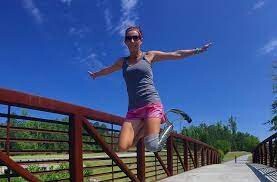
To change things up, Hunt-Broersma has done her marathons on the roads, trails and the treadmill. More than just a change of scenery, varying the surface has helped her physically, as well. After finding that the road was beating up on her body, she’s moved many of her runs to a dirt trail near her home that’s more forgiving, and alternated that with runs on the treadmill. “The treadmill works my muscles slightly differently than running outside, so it helps a bit with recovery,” she says.
Of course, running with a prosthetic leg comes with its own set of challenges that a runner with two legs would not have to deal with. The volume of running Hunt-Broersma is doing every day frequently causes swelling behind her knee near the bottom of her stump, which pushes the bone out of position. A daily part of recovery for her is icing her stump and massaging it to bring down the swelling so the bone can move back to the correct spot. “I’ve had to stop mid-run a few times to massage my stump so I can get going again,” she says.

The highs and lows
Unsurprisingly, in a journey of this length and magnitude, there have been good days and bad days. “Sometimes, after I have a really difficult run, I wonder how I’m going to get through another one the next day,” says Hunt-Broersma. “But then the next day feels like I didn’t run at all the day before.”
There have also been some particularly difficult days, like on day 35, when she ran a half-marathon race in the morning, then came home and ran another 21.1K to complete her marathon distance for the day. A few people called her out on social media, arguing it didn’t count because she split it into two runs, so to be safe, she ran another full marathon that day. That made for a total of 84.4 kilometers in one day, after 34 consecutive marathons.
Day 72 was also particularly tough. “I had a bit of an emotional breakdown on my run yesterday,” she says. “I was questioning whether or not I could do this, so I cried a bit, then picked myself up and got the job done.”
When asked how she gets through her runs every day, Hunt-Broersma says she tries to focus on taking it one mile at a time. On the really tough days, she gives herself mid-run pep talks to remind herself of her capabilities and her goal (if you live in Arizona, don’t be alarmed if you see a woman running toward you talking to herself).
Finally, she says the support she’s received from her family and friends has been phenomenal, and her daughter has even joined her for a few miles here and there. “My kids are always coming home from school, asking me if I’ve run my marathon yet today,” she says. The support from the online community has also been overwhelming, and Hunt-Broersma has received several messages from fellow runners, who’ve said she’s inspired them to get out the door for their run, even when they didn’t feel like it.
Hunt-Broersma has 27 days left to go on her journey and can use all the support and well wishes she can get. She is also 65 per cent of the way to reaching her fundraising goal of $10,000 for the Amputee Blade Runners organization, which provides running blades for amputees. You can donate to the cause on her GoFundMe page, and follow her progress on Instagram.
(03/31/2022) Views: 949 ⚡AMPby Running Magazine
Bladerunner Jacky Hunt-Broersma, is aiming to complete 100 marathons in 100 days
This year, Jacky Hunt-Broersma is looking to add another record to her name. The multiple-time ultramarathon finisher and world record-holder has committed to running 100 marathons in 100 days, to break the Guinness World Record for most consecutive marathons.
Broersma got the idea after she saw Alyssa Clark of Vermont set the record last year at 95 days. Clark had been aiming to hit 100 marathons but was forced to cut her challenge short after contracting COVID-19. “This got me thinking, maybe this is something I could take on and it would be a great way to start the new year and help me build up a great base for The Moab 240 race in October,” says Broersma.
Being an experienced ultramarathoner, Broersma is well-equipped to handle a challenge of this magnitude. She finished a 100-mile race at the beginning of January, and although she says she hadn’t fully recovered by the time she started her marathon streak, she says this challenge is more mental than physical. For this reason, staying positive through each of her runs has been the most important key to her success thus far.
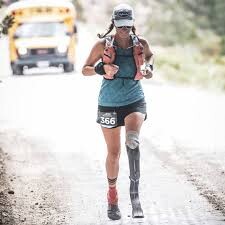
When we first spoke with Broersma, she had completed 10 marathons, and by the time of publishing that number had grown to 14. She tells us her biggest challenge is getting enough sleep to recover. “I am amazed at how incredible our bodies are,” she says. “The first five marathons were tough because my body was adjusting to the distance, but slowly my body started adapting.” She adds that her shin is hurting and her knee feels a bit sensitive, but her stump is holding out very well.
Broersma says she’s taking each day as it comes and trying her best to listen to her body. “Some marathons are slower than others and some are faster, it just depends on how my body feels in the morning,” she says. “I am making sure I use my massage gun every day on any tight muscles, eating well so I can recover and icing my stump if it is needed.”

Running for a reason
Aside from trying to break the Guinness World Record, Broersma is using her challenge to raise money for Amputee Blade Runners, an organization that provides running blades for amputees. She explains that running-specific blades can cost between $10,000 and $20,000, and in the United States they’re not always covered by health insurance so many amputees don’t have the opportunity to run the way she has.
“When I became an amputee one of the biggest challenges for me was accepting the way I looked and it can be a really tough journey,” says Broersma. “Running changed that for me, it gave me confidence in my body and confidence to be who I am. Running makes me feel strong and fearless and grateful for the body I have, even when part of it is missing. This is what I want for all amputees.”
So far, Broersma says she has had incredible support from around the world, with people sending messages of encouragement every day. She’s also received messages from people with disabilities who’ve been inspired by her to start running and hiking, which was her ultimate goal to begin with. “I hope by doing this that it will inspire people to get out of their comfort zones, even if it is to have the courage to take on their first 5k race,” she says. “We are always more capable than we think.”
If you’d like to support Broersma and follow along with her journey, you can keep up-to-date with her on her Instagram or Twitter pages where she posts daily updates, and you can donate to her cause on her GoFundMe page.
(02/01/2022) Views: 1,005 ⚡AMPby Brittany Hambleton
Marko Cheseto survived frostbite and double leg amputation, set to run Boston Marathon
Marko Cheseto will line up for Monday’s Boston Marathon with justified confidence: he has the fastest known time for a double-leg amputee: 2 hours 37 minutes and 23 seconds. In other words, Cheseto is capable of running six-minute miles for just over 26 miles.
The journey he took to get to this stage took him across two continents and through immense physical and emotional pain.
Cheseto’s athletic career began as a boy in Kenya, when he still had both of his feet. He was inspired by Tegla Loroupe, the first African woman to hold the world marathon record and win the New York City Marathon, who also happened to be his aunt.
Cheseto was later recruited to run at the University of Alaska, where he ran the 5k and 10k. He also convinced his coach to recruit his cousin and close friend, William Ritekwiang. But in 2011 Ritekwiang took his own life, and Cheseto blamed himself for not being able to help.

One night, deep in grief, Cheseto took some antidepressants, went for a run in the woods, and blacked out. He had overdosed. He woke up in the snow three days later, unable to feel his legs. His feet were frostbitten and developed gangrene, and his legs had to be amputated below the knee.
His world had shifted. He was fitted with walking prostheses. At first, Cheseto didn’t think running would be in his future. He had never seen anyone wearing prostheses, and he had never heard of the Paralympics.
But he started running again in 2012 on his walking prostheses. Although they were not made for running, it felt good, he says. He decided not to let the trauma of losing his cousin and his feet get the best of him. “I was trying to find a purpose in life, something that I could be proud of,” he says. “And running was that.”

In 2013, he received his first running prostheses from the Challenged Athletes Foundation (CAF). Running blades can cost $15,000 each, and they need to be highly specialized for each person.
Cheseto decided to try to qualify for the 2016 Paralympics in sprinting events, but that didn’t work out, so he shifted course to the marathon. His first was the 2018 New York Marathon, and his second was Boston in 2019.
“At first, running was for me. I wanted to do this for my own sanity,” Cheseto says. But he soon realized that other people related to what he had been through. “The only difference between me and so many people that I have talked to and have shared their pain is that mine is physical pain. I am not saying I don’t have internal struggles and pains just like everyone else … but my physical wounds helped people to feel comfortable sharing their pain.”
Cheseto also works with amputees in his job as a technician at Prosthetic & Orthotic Associates, a company that fits patients with prostheses and that he joined after receiving his own prosthetic care there for years. “That ability to be able to help someone else get a walking or running leg was just so rewarding,” he says.
But Cheseto knows there are still challenges for athletes like him. One example came in February 2020, when he was competing at the Disney Princess Half Marathon, which he had hopes of winning. The race has separate categories for athletes with disabilities and those without. Cheseto said that before the race, the race director, Jon Hughes, told him that if he finished first overall, he wouldn’t be recognized as the overall winner.
The future looks secure for Cheseto. As well as his job with prosthetics, he is sponsored by Össur and Nike. He says that their help, and the ongoing support he gets from POA and his wife, Amanda, and the rest of his family have allowed him to reach this point.
In the process of sharing his story, Cheseto has become an advocate for mental health. “I have struggles every day about what I went through and losing my feet. But then, at the same time, I’m asking myself: How have I been able to will myself this far, still having a positive attitude toward life? – most days, anyway,” he says. The answer was being able to “transition from your old self to your new self,” which many people struggle to do, he says.
(10/07/2021) Views: 928 ⚡AMPby Allison Torres Burtka
Boston Marathon
Among the nation’s oldest athletic clubs, the B.A.A. was established in 1887, and, in 1896, more than half of the U.S. Olympic Team at the first modern games was composed of B.A.A. club members. The Olympic Games provided the inspiration for the first Boston Marathon, which culminated the B.A.A. Games on April 19, 1897. John J. McDermott emerged from a...
more...Hunter and Davis are officially melting the Internet: Hunter on Instagram - They said I’d never walk, So I learned to run instead!
#TeamUSA long jumper Tara Davis & Paralympic athlete Hunter Woodhall are officially melting the Internet!! I hope they both win gold in the #TokyoOlympicGames!! 🇺🇸 Posted Gary Allen on FB.
After two-time Paralympic medalist Hunter Woodhall ran a season-best 11.04 seconds in the 100-meter T62 sprint at the U.S. Paralympic Team Trials for Track and Field on June 18 in Minneapolis, he picked up his phone and FaceTimed his girlfriend immediately upon stepping off the track.

Tara Davis was already on the other side of the country, preparing for the long jump competition at the U.S. Olympic Team Trials in Eugene, Oregon. Woodhall and Davis, who train at the University of Arkansas and University of Texas, respectively, are accustomed to regular FaceTime calls at all moments in time to keep their long-distance relationship strong.
In Tokyo, Woodhall is expected to compete in both the 100 and 400; at the last Paralympic Games in Rio he won silver in the 200 and bronze in the 400. While he’s no longer competing at the NCAA level — he turned pro in January — he’s still training with the Arkansas team, having adjusted his schedule to peak at Trials and the Games as opposed to indoor and outdoor collegiate nationals.
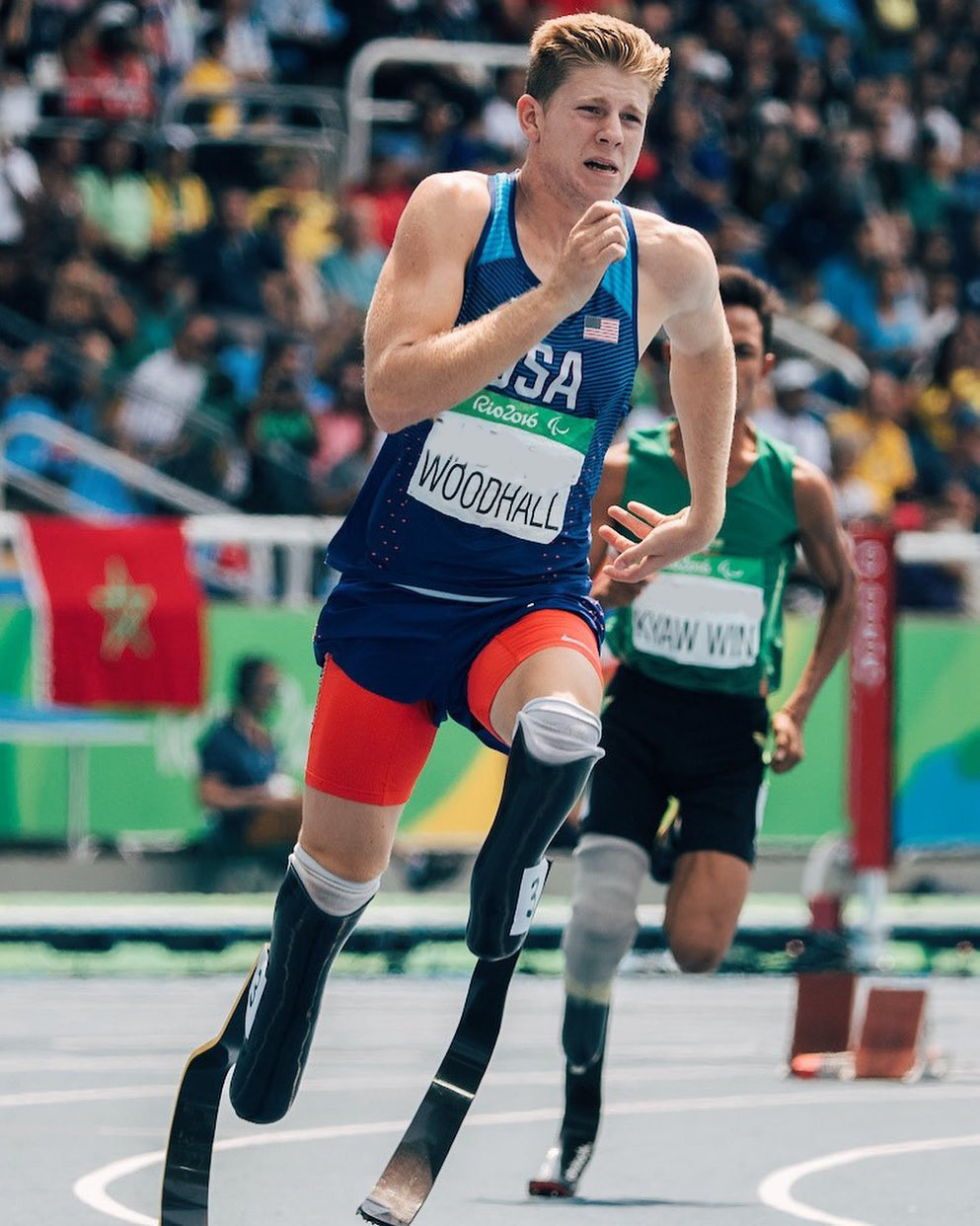
Davis was competing in her second Olympic Trials after finishing 19th in the long jump in 2016. She has held the American junior record in the event since 2017 and earlier this season broke Jackie Joyner-Kersee’s collegiate record set back in 1985.
Davis is also No. 2 at the junior level in the 60-meter hurdles.“I can't put into words how I'm feeling right now, there just are so many emotions,” Davis said to the website of the University of Texas, where she was an NCAA indoor and outdoor national champion.
“I say it all the time, I didn't think I was going to be here. I was going through so much I just didn't ever think I was going to be at the Olympic Trials. But here I am, and I was so grateful for the opportunity, and I took advantage of it.
”The couple, both 22, have been chronicling their journeys in their own YouTube channel, and Woodhall, a TikTok star who has more than three million total social followers across all his platforms, has been profiled by the likes of the New York Times and “The Ellen DeGeneres Show.
”The first double amputee track and field athlete to have earned a Division I athletic scholarship insists there will be as many reasons to follow the Para track and field athletes like himself in Tokyo, as the Olympic athletes like Davis.
“The biggest reason to tune in is because of the stories that come along with the Paralympics — things that people have had to fight through and go through just to be here,” he said.
“At the end of the day we are all humans and all in the same field. If people can come out here and compete after the things they’ve gone through and still be chasing their dreams, that shows that everyone’s on the same level.”
(07/28/2021) Views: 1,631 ⚡AMPWhen It’s Time to Rethink Your Hydration
Here are 5 of the most common hydration mistakes—and how to avoid them.
It should go without saying that proper hydration results in a better chance of crushing your performance goals. But too often, people fall into some surprising hydration traps before, during, and after their workouts that keep them from performing their best when it counts most. To help set you on a path to hydrating like a pro, we teamed up with a Honey Stinger athlete and pro sports dietitian to bring to light the hydration mistakes you may be making and the fixes that will make sure your fluids are perfectly topped up.

You wait too long to drink
For professional double-amputee runner and Honey Stinger athlete Brian Reynolds, the hydration window for a big run actually begins the night before. “If I try to drink too much right before a race it leaves me with a belly full of water sloshing around and a bloated feeling that is not comfortable for the first few miles.” Instead, Reynolds, who has broken multiple world records for double below-the-knee amputees in the marathon (3:03:22 PR) and half-marathon (1:17:05 PR), takes in two bottles of Honey Stinger Rapid Hydration Mix (“Prepare” Formula) the night before, then a modest 4 to 6 ounces of fluid the morning of his workout.
Allison Maurer is a professional sports dietitian for Honey Stinger and Major League Baseball’s Pittsburgh Pirates. She also supports Reynolds’s night-before “hyperhydration” strategy.
“It’s best to start early with your hydration using an electrolyte drink instead of panicking shortly before a race and trying to drink too much to make up for the lost time,” she says. If you find yourself needing to pee about an hour before your workout, it’s a good sign you’re well-hydrated.
There is only water in your bottle
“Until I settled on Honey Stinger, I used to suffer on my long runs by not taking in enough carbohydrates and electrolytes,” Reynolds confesses. He now brings along a 14-ounce water bottle spiked with Honey Stinger “Perform” Formula and supplements this with fluids from aid stations during races.
Maurer says plain water lacks the electrolytes to improve muscle function and help stave off cramping, and the fast-absorbing carbs to fuel the working body. “The combination of carbs and sodium helps your body hold onto more water for better hydration.”
She says the honey used in Honey Stinger Rapid Hydration Mix absorbs quickly for improved digestion and more efficient fueling without gut rot, while its sodium can help replace a portion of the sodium lost on the run—as much as 1,700 milligrams of sodium per liter of sweat.
You don’t train your gut
It took Reynolds years of trial and error to fine-tune his run hydration and fueling to a method that works for his system. “I suffered through numerous stomach issues until I figured out that the Honey Stinger products settled things down and helped me perform at my best.”
Maurer agrees with taking a highly individualized approach to sports nutrition. “You need to train your gut to see what works specifically for you, in the conditions you’ll face.”
In other words, there is no universal fluid, electrolyte, and carbohydrate guideline to use during workouts. Maurer explains you need to test your hydration strategy during training to gauge tolerance instead of trying something different during a big event. 

You gulp it all down at once
Reynolds has learned that lots of little sips spread throughout works better than guzzling back large amounts less frequently when it comes to midrun hydration. “Drinking small amounts every mile or two is easier on my stomach and keeps my mouth from drying out.”

Maurer stresses that your goal is to avoid the sluggish, ground-down feeling brought on by dehydration and low fuel stores instead of trying to correct the dreaded bonk after it occurs.
Frequently consuming a well-designed hydration product like Honey Stinger Rapid Hydration Mix ("Perform" Formula) will keep you charging hard, as studies have suggested that drinking a predetermined amount of fluid at set times can deliver greater performance gains than simply consuming liquids based on thirst.
You overlook postrun hydration
From experience, Reynolds knows that his hydration needs don’t grind to a halt once he crosses the finish line. “I make a plan to drink 16 to 24 ounces of fluid with the electrolyte-based Honey Stinger Rapid Hydration Mix ("Recover" Formula) shortly following a big run and then keep on hydrating throughout the day.” He knows his recovery will suffer if he doesn’t rehydrate properly.
But Maurer says to space out your rehydration efforts instead of drinking huge amounts of fluids at once. “Drinking too much can make you feel full, which is counterproductive to eating enough to properly refuel.”
Research shows that a honey drink can improve recovery by increasing hydration and replenishment of spent energy stores, leading to better performance during your next workout.
(06/06/2021) Views: 897 ⚡AMPby Runner’s World
More than 13,000 runners are getting prepared for virtual Pittsburgh Marathon
Runners from across the United States and the world are gearing up to run their committed distances from wherever they are as the DICK’s Sporting Goods Pittsburgh Marathon goes virtual in 2020.
13,000 runners from 43 states and 5 countries will either run outside or on treadmills on what should’ve been the weekend of the 2020 race.


Thirty percent of runners this weekend will be completing their first marathon and 23% of runners will be completing their first half-marathon.
All ages will be running this weekend or have already completed their virtual marathon, including 81-year-old Henry Wood, a Pittsburgh native. Wood finished his 28th Pittsburgh Marathon and 51st marathon overall on April 19.
Raffi Wilbur is a 5-year-old double-amputee who will be completing the Chick-Fil-A Kids Marathon alongside his father.
More than 1,100 runners have already raised over $350,000 for local and national nonprofits.
(05/01/2020) Views: 1,372 ⚡AMPDick's Sporting Good Pittsburgh Marathon
This race is your game - however you decide to play it. As a competitor. A fund raiser. An enthusiast. A veteran. A team player. It's whatever you want it to be. It's whatever you make it. It's YOUR game..... Run it. Play it. Own it. Love it. Runners will race on the North Shore of Pittsburgh, cross each of...
more...Former soldiers ran the Lake Placid half marathon to raise money for the Rangers Lead the Way Fund
Roughly 1,000 people completed either the Lake Placid Marathon or Half on Sunday, and a few runners carried military packs.
John Byrne, a U.S. Army veteran, said his group was running to raise money for the Rangers Lead the Way Fund.

“It’s a fund that helps fallen (Army) Rangers and their families deal with the funeral costs and other costs,” Byrne said. “Or amputees. They come to your house, and they readjust the house so you’re comfortable after your service time.
“I’m not a Ranger. I was an infantryman with Anthony (Cambareri). He’s the spearhead of the whole thing.”
The group was made up of Byrne, Cambareri, Dan Geraghty and Joey Gay. The four donned Lead the Way Fund shirts and military packs during the half marathon portion of the Lake Placid Marathon.
“I’m a 9/11 survivor. I was at the towers on 9/11,” Geraghty said. “I was actually just working there. I was a civilian at the time. But John was one of the guys who deployed. Anthony was one of the guys who deployed.
“When John got back eight years ago, we raised money for the Warrior Project. We were just looking for people to support and keep the message out there. Just because this never-ending war continues doesn’t mean that people haven’t been hurt, that they don’t need help.
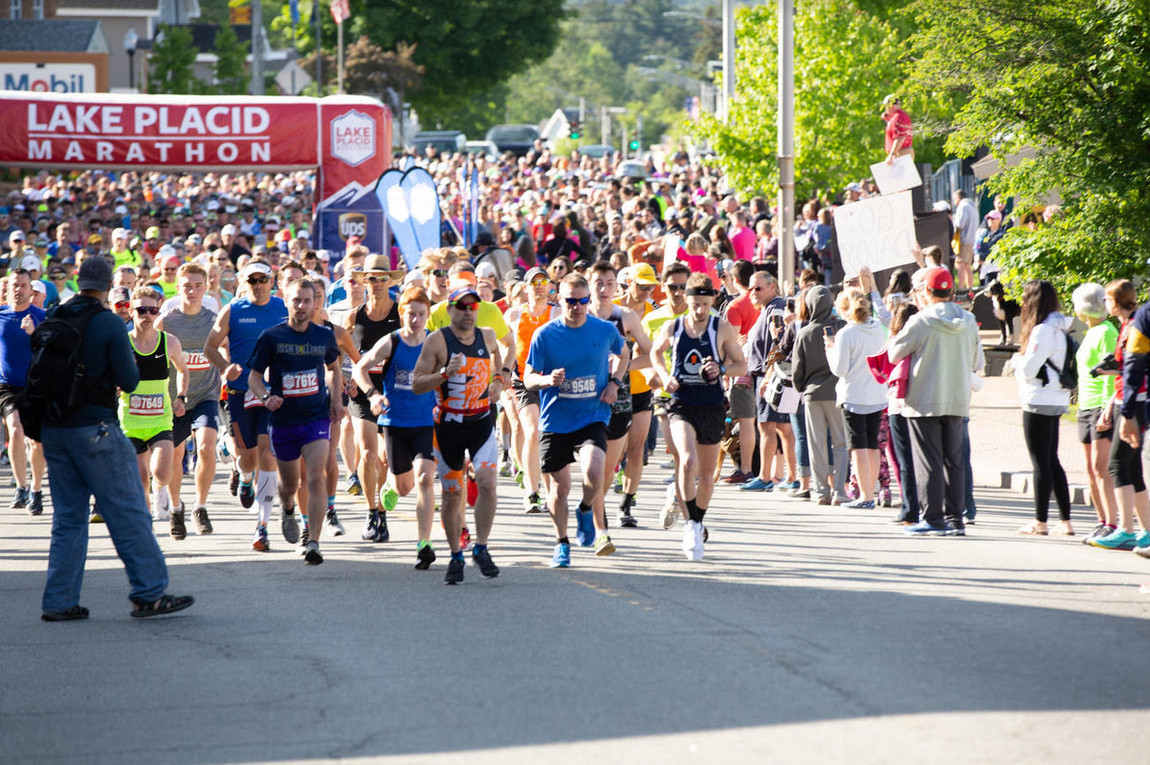
“I know it’s cliche, but some gave all, and a lot of gave plenty,” he continued. “And they’ve got to live with that. They’ve got to live with the results for a long time, so we want to help them the best we can.”
The Army Ranger Lead the Way Fund offers former Rangers a number of services, including help with medical costs and transitioning into a career after the military. It also helps Gold Star families, those whose loved ones have died in service to the country.
This was the 15th annual marathon. Three runners who recently graduated from Boston University took the top three slots in the men's marathon, with Johnny Kemps claiming the title. Kemps won the race with a finish time of 2 hours, 43 minutes and 2.4 seconds. He was followed across the line by teammates Alexander Seal (2:43:33.8) and Zachary Prescott (2:45:12.3).
(06/12/2019) Views: 1,607 ⚡AMPCedric King is a double amputee that hopes to inspire others as he takes on the Cherry Blossom Run ten miller
Retired U.S. Army Master Sgt. Cedric King sustained severe injuries while serving in Afghanistan in 2012: He lost part of his right arm and hand, and both of his legs were amputated.
King spent the last three of his 20 years of service at Walter Reed National Medical Center in Bethesda, recovering from injuries.

But this Sunday, he’s going to lead “Team Cedric” in the Cherry Blossom Ten Mile Race. And the objective is not just to cross the finish line, but to inspire others to take on challenges that may seem insurmountable.
“The hard part about it isn’t necessarily the 10 miles,” King said. “The hard part about it is — I’m running with no legs — with prosthetic legs.”
“Team Cedric” includes members of Pentagon Federal Credit Union and the Pentagon Federal Credit Union Foundation. King said some of his teammates have only ever run a mile or two at a time, and while some are not sure they can make it 10 miles, they’re all determined to try.

King wants people facing difficult life situations to feel that same determination and persistence — people who may be receiving chemotherapy treatments, people who are struggling single mothers, or people who are facing business, community or financial hardships can all look at “Team Cedric” and see a group of people facing their fears.
“If we can face our fears and do it afraid, then guess what,” he asked. “You can do it afraid too.”
“And, when we make it to the finish line,” King said, “maybe that’s a representation of somebody else making it to their finish line.”
King said it’s proof that “if we can do it, then you can do it too.”
(04/06/2019) Views: 1,935 ⚡AMPCherry Blossom Ten Mile Run
The Credit Union Cherry Blossom is known as "The Runner's Rite of Spring" in the Nation's Capital. The staging area for the event is on the Washington Monument Grounds, and the course passes in sight of all of the major Washington, DC Memorials. The event serves as a fundraiser for the Children's Miracle Network Hospitals, a consortium of 170 premier...
more...Stefan LeRoy a Double amputee is ready to run the Disney marathon
From hardships to triumph, nothing is stopping a retired U.S. Army Specialist from hitting the pavement and proving anything is possible. Stefan LeRoy lost both his legs while serving overseas.
This weekend, the 27-year-old is taking on a new challenge at the 2019 Walt Disney World marathon.
LeRoy isn’t running just one race, not even two; he is running the 5K, 10K, half marathon and is hand cycling the full marathon on Sunday.
“It’s something that has been a part of my life,” he said.
In June of 2012, LeRoy was deployed with the 82nd Airborne Division when he stepped on a bomb while carrying a fellow soldier to a waiting helicopter seconds after an explosion went off around them in Afghanistan.

“I lost both my legs instantly,” he said. “Single above the knee and a single below the knee amputee.”
The traumatic incident that occurred thousands of miles away from home never stopped him from achieving his goal: to experience the thrill of running again.
LeRoy struggled with depression and anxiety until he got his prosthetic legs and running blades.
He describes his training as challenging, saying he suffers from blisters and painful chafing.
“I also have to be careful of overdoing it,” LeRoy said. “The recovery was a long process. It was very frustrating. I wasn’t initially able to walk in prosthetics, but I focused on adaptive sports. I made it that I was able to stay positive.”
Every strides LeRoy takes is a massive accomplishment.
His resilience is fueled by the support with the Achilles International Freedom Team, "an organization that encourages wounded vets to participate in running events."
His other support system is David M. Cordani, president and CEO of Cigna, who will accompany and guide LeRoy during the race again this year.
“You keep training. You keep stepping it up. You keep pushing through it,” LeRoy said.
(01/10/2019) Views: 1,369 ⚡AMPAdrianne Haslet a Boston bombing amputee was struck by car
Adrianne Haslet, a professional dancer who lost her left leg in the Boston Marathon bombing in 2013, was in serious condition in hospital after being struck by a car on Boston’s Commonwealth Avenue on Saturday. Haslet posted the information on Instagram, it was picked up by the Associated Press and retweeted by Haslet’s friend Shalane Flanagan, third-place finisher in last year’s New York City Marathon.
Hasket was in a crosswalk at the time. She says she was “thrown into the air and landed, crushing the left side of my body… I’m completely broken. More surgery to come.”
According to the AP report, the driver claimed he was turning and did not see Haslet because it was dark out and raining, and because she was wearing dark clothing. He was charged for failing to stop for a pedestrian in a crosswalk.

Haslet was in the crowd near the finish line in 2013 when she was injured in the second blast. She had shrapnel wounds in her right leg, and her left leg had to be amputated below the knee. A highly ranked competitive ballroom dancer, Haslet was able to recover and return to dancing with her prosthetic leg, and in 2015 she performed a dance at the Boston marathon finish line.
(01/07/2019) Views: 1,396 ⚡AMPSarah Reinertsen has been the only amputee to have completed the World Marathon Challenge
For a long time, people with disabilities were defined by what they couldn't do -- Sarah Reinertsen is choosing to be defined by what she can do as an amputee.
She's not just breaking down barriers, she's blazing a trail for all who come after her.
"Growing up, I knew I was different, right, and I was OK with being different but I was not OK with being told I couldn't do something," Reinertsen said.
"I was born with a tissue disease that meant that my thigh bone stopped growing, so although I had two legs, my left leg was extremely shorter than my right leg."
Reinertsen and her family decided to amputate her leg when she was just seven years old. "That was a really hard time for me," she said.
From age 7 to 11, Reinertsen struggled to make peace with her new reality. "I was the only kid in my entire school that had a physical disability that you could see," she said.
"I had coaches that wouldn't let me play with the other kids on the main field. They would make me go kick a soccer ball on the side of the wall by myself and so for many years of my childhood I used to believe that narrative. I used to believe that I wasn't good enough."
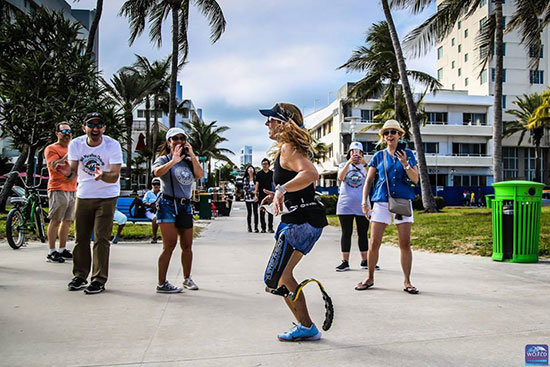
That all changed when she went to one of her dad's 10k races -- like she did most weekends. But this race changed her life.
"There was a woman in the race who was an amputee and she was doing the 10k and I just thought, I had never seen another amputee on one of these road races with my dad and so I just thought 'wow, if she can run in this six mile race, maybe I could run and do a six mile race,'" Reinertsen said.
She's been running ever since. She learned the ins and outs of prosthetics and backed by Nike and Ossur Prosthetics, Reinertsen ran one race after another. But that was just the beginning.
"I knew this guy named Jim McClaren who had done an Iron Man on a prosthetic leg and I was like 'Jim that's so cool that you did an Ironman, I want to do an Iron Man just like you' and he said 'well I don't know of a girl on a prosthetic that can do it' and I was just like 'are you kidding, you do know a girl because you're looking at her, I'm going to do the Iron Man,'" Reinertsen said.
She not only did the Iron Man, she qualified for the world championship in Kona, Hawaii. She was one of only 10 in the physically challenged division and the only woman.
"I just believed that I could do it," she said. That belief has knocked down barriers all over the world.
She's also the only amputee to have completed the World Marathon Challenge. That is running seven marathons on seven continents in seven days.
"It's sort of like a long race with sort of like naps in between," she said.
When she's not taking the athletic world by storm herself, Reinertsen is working with Nike's Innovation Kitchen, designing sportswear that gives independence to anyone who wants it, regardless of the physical challenges they may face.
(12/20/2018) Views: 1,491 ⚡AMPJohn Wayne Walding a former Green Beret, who lost a leg in battle is running his first marathon at BMW Dallas
Sunday's BMW Dallas Marathon is an opportunity for Staff Sgt. John Wayne Walding, a former Green Beret Special Forces soldier from Frisco, to achieve what he once thought was impossible. "Any time I tell myself I can't do something, I like to prove myself wrong," said Walding, a below-the-knee amputee. "No matter what, put your mind to it, and you can overcome pretty much any obstacle." Walding says he learned the meaning of "I can't" when he lost his lower right leg on April 6, 2008, in the battle of Shok Valley in Afghanistan. The Dallas marathon serves as a colossal challenge to remind him and to show his four children that there's little in life he cannot do. "John didn't think he could run 13 miles when we started this, and he definitely didn't think he could run a marathon," said his coach Mo Brossette, who has worked with Walding for two years. "Once he changed his mind-set and understood that that was the limiting factor, everything became possible." Walding has spent the past decade preparing to tackle a full marathon. He couldn't have endured this most recent 16-week build-up without years of training, mentally and physically. "It's going to be one of the hardest things I've ever done," said Walding, 37. "I'm a glutton for punishment. You don't become a Green Beret because you don't like to sweat a little bit and exert some energy." (12/05/2018) Views: 1,682 ⚡AMPMarko Cheseto who lost both of his feet to frostbite in 2011 ran and completed his first marathon last week
A former University of Alaska Anchorage runner who lost both of his feet to frostbite in 2011 ran his first marathon and became an American citizen last week. The Anchorage Daily News reports 35-year-old Marko Cheseto finished 613th overall out of nearly 53,000 runners at the New York City Marathon. Cheseto went to the Anchorage university from Kenya in 2008 on an athletic scholarship, quickly earning honors in track and cross country. Cheseto's feet were amputated during his senior year in November 2011 after he went missing in the woods near campus when temperatures dipped to single digits. He began running again 18 months later. Cheseto finished the marathon last week in 2 hours, 52 minutes, 33 seconds — about 10 minutes off the world record for a double-leg amputee. (11/13/2018) Views: 1,754 ⚡AMPAnother look at the New York City Marathon from the pack of 52,812 runners
Seven mornings ago, my wife Jasmin and I joined thousands of others in Staten Island as a loud “BOOM!” erupted, signaling the start of the earth’s biggest 42K race: the New York City Marathon. Then, Frank Sinatra’s “New York, New York” song blasted over the loud speakers. Our hearts trembled, legs shuffled, arms raised.By day’s end, there would be 52,812 of us who traversed the 42.195 km. distance — a world record for the most number of marathon finishers.From Staten Island, we climbed the 4.1-km.-long Verrazzano-Narrows Bridge, descending into Brooklyn. After a dozen or so miles, we disembarked in Queens, alighted in Manhattan, passed through the Bronx before finishing in Central Park. In all, the NYC Marathon guided us along all of New York City’s five boroughs.The crowd and cheering were incredible. Imagine 2.5 million people coming out of their apartments to line the streets with posters that read, “You Run Better Than Our Govt. and Trump!” Children carried placards with signs that said, “Tap Here For Power!” Dozens of live bands scattered the route. Beer overflowed as partygoers high-fived us. Runners donned costumes, some with chicken-head attire and others dressed as Captain America. One marathoner was an amputee, painfully carrying one leg in front of the other. The weather last Nov. 4 was perfect. It rained for two straight days before the race and for two consecutive days after — but not on race day, when the sun shone brightly and the skies were light blue and the temperature a cool 12C degrees.Jasmin and I finished in six hours and 48 minutes. We had a good time. And by “good time,” I don’t mean a fast, good time; but “good time,” meaning we had a fascinating husband-and-wife bonding session touring America’s biggest city — a running experience that we will forever cherish. (11/11/2018) Views: 1,709 ⚡AMPby John Pages
Adriele Silva hopes to be the first double amputee to finish the New York City Marathon
Adriele Silva, 31, from Brazil looks forward to crossing the finish line of the 2018 TCS New York City Marathon on Sunday, November 4, 2018. A spokesperson for the New York Road Runners believes she will be the first female double amputee to complete the full New York City Marathon. “I hope to inspire people when they see me run and challenge them to go after things that seem unachievable,” said Silva, who will be running her first full marathon. “Where I come from, people often look down on you for having a disability, but I don’t think about that. When I face a challenge, I look for ways to overcome it. I see the possibilities, and that keeps me going.” Silva’s road to the New York City Marathon began in 2012, when she went to a hospital in her hometown of Jundiai, outside of São Paulo, Brazil, after feeling severe pain. Having received pain medications, she was sent home. Overnight, her situation worsened. She returned to the hospital the next day to find out that her problem was serious — a kidney stone had clogged her urinary tract and caused an infection. Within hours, Silva was in an induced coma. For 20 days she remained comatose, her body fighting a losing battle against the bacteria. During that time, the infection led to a lack of blood circulation in her legs. To save her life, doctors had only one choice: to amputate her legs. They brought her out of the coma to get her consent to proceed with the amputation. When she was finally cleared of the infection after 64 days, the now bilateral amputee left the hospital to go and learn to live again. “Before the amputation, I had no desire to run,” she says. “After it happened, I started getting more interested. I wanted to become normal again.” Since then, Silva has taken up running, cycling, swimming, and other sports. She has participated in 20 running races in Brazil and in China, where she completed the Great Wall Half Marathon in 2018. (10/25/2018) Views: 2,010 ⚡AMPSal Pellegrino will run the NYC Marathon for the 27th time on his 75th birthday
Sal Pellegrino will be celebrating his 75th birthday, with some 50,000 people on the streets of New York City. Sal will be running in the New York City Marathon, the 27th time he's tackled the challenging course that starts in Staten Island and traverses all five boroughs before ending in Central Park. Pellegrino ran his first NYC Marathon at age 48 and has returned every year except 2012 when the event was canceled in the aftermath of Hurricane Sandy, and one year when he had surgery. He ran solo for the first 15 marathons but for the past dozen years has acted as a volunteer guide with Achilles International, which aids disabled participants. Over the years, he has guided people who are blind and deaf, amputees, and those with multiple sclerosis, vertigo, and Lou Gehrig's disease. This year, he'll run the course with a woman who suffers from dizziness and seizures. "It's quite an inspiration that they have the courage to do this," Pellegrino said. He has no plans to stop running any time soon. (10/17/2018) Views: 1,552 ⚡AMPBrian Reynolds is a double amputee and Runs 3:03:23 at the Chicago Marathon
I am so proud of Brian Reynolds, he ran a new personal best, 3:03:22 at the Chicago Marathon this morning. He is a double amputee and I think this is an American record. We didn’t make his ultimate goal of going sub 3 however. We battled Mother Nature all day, a fall(that was on me, I thought I was close enough, I was not) and some cramps but he never wavered and fought till the end. It was inspiring. During the 22nd mile, though, Reynolds fell, suffering a concussion and knocking his time down significantly. Always one to finish what he started, 30-year-old Reynolds went on to finish. Brian said, "Despite not reaching my goal today I have still run a personal record in every single one of my marathons," said Reynolds moments after the race. "Even on my worst day I have the motivation, determination and grit to dig deep and get to that finish line.” If you ever have a chance to guide I highly recommend it. Not sure I will be hired again but if given the chance I am there. Editor’s note: Michael Wardian is an international know marathoner and ultra marathoner. (10/07/2018) Views: 2,154 ⚡AMPby Michael Wardian


